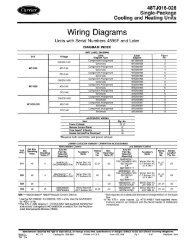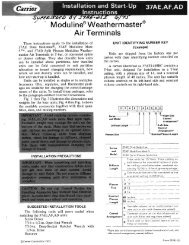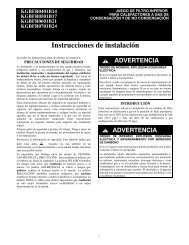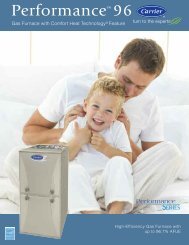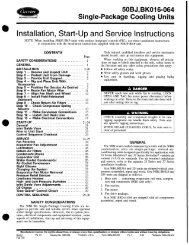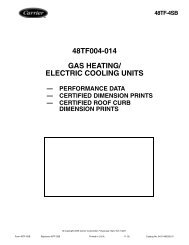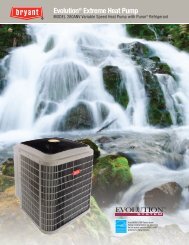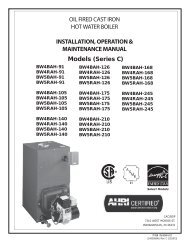Start-Up, Operation, and Maintenance Instructions
Start-Up, Operation, and Maintenance Instructions
Start-Up, Operation, and Maintenance Instructions
You also want an ePaper? Increase the reach of your titles
YUMPU automatically turns print PDFs into web optimized ePapers that Google loves.
LEGEND<br />
C — Contactor<br />
FU — Fuse, 3 Amps<br />
HP — High-Pressure Cutout<br />
OL — Compressor Overload<br />
T’STAT — Internal Thermostat<br />
Compressor Terminal<br />
Contactor Terminal<br />
Overload Terminal<br />
Pumpout Unit Terminal<br />
*Bimetal thermal protector imbedded in motor winding.<br />
Fig. 35 — 19XR Pumpout Unit Wiring Schematic<br />
OIL RETURN<br />
LINE<br />
CONNECTION<br />
CONDENSER<br />
WATER<br />
CONNECTIONS<br />
REFRIGERANT<br />
INLET VALVE<br />
Fig. 36 — Optional Pumpout Unit<br />
Chillers with Storage Tanks — If the chiller has isolation<br />
valves, leave them open for the following procedures.<br />
The letter “C” describes a closed valve. See Fig. 17, 18, 29,<br />
<strong>and</strong> 30.<br />
TRANSFER REFRIGERANT FROM PUMPOUT STOR-<br />
AGE TANK TO CHILLER<br />
1. Equalize refrigerant pressure.<br />
a. Use the PIC II terminate lockout function on the<br />
PUMPDOWN LOCKOUT screen, accessed from<br />
69<br />
the CONTROL TEST table to turn on the water<br />
pumps <strong>and</strong> monitor pressures.<br />
If the chilled water <strong>and</strong> condenser water pumps are not<br />
controlled by the PIC II, these pumps must be started <strong>and</strong><br />
stopped manually at the appropriate times during the refrigerant<br />
transfer procedure.<br />
b. Close pumpout unit valves 2, 4, 5, 8, <strong>and</strong> 10, <strong>and</strong><br />
close chiller charging valve 7; open chiller isolation<br />
valves 11, 12, 13, <strong>and</strong> 14 (if present).<br />
c. Open pumpout unit/storage tank valves 3 <strong>and</strong> 6,<br />
open chiller valves 1a <strong>and</strong> 1b.<br />
VALVE 1a 1b 2 3 4 5 6 7 8 10 11 12 13 14<br />
CONDITION C C C C C C<br />
Follow Steps d <strong>and</strong> e carefully to prevent damage from<br />
freeze-up.<br />
d. Slowly open valve 5 to increase chiller pressure to<br />
68 psig 35 psig (141 kPa) for HFC-134a. Feed<br />
refrigerant slowly to prevent freeze up.<br />
e. Open valve 5 fully after the pressure rises above<br />
the freeze point of the refrigerant. Open liquid line<br />
valves 7 <strong>and</strong> 10 until refrigerant pressure<br />
equalizes.<br />
VALVE 1a 1b 2 3 4 5 6 7 8 10 11 12 13 14<br />
CONDITION C C C<br />
2. Transfer the remaining refrigerant.<br />
a. Close valve 5 <strong>and</strong> open valve 4.<br />
VALVE 1a 1b 2 3 4 5 6 7 8 10 11 12 13 14<br />
CONDITION C C C<br />
b. Turn off the chiller water pumps using the CVC/<br />
ICVC (or manually, if necessary).<br />
c. Turn off the pumpout condenser water, <strong>and</strong> turn on<br />
the pumpout compressor to push liquid out of the<br />
storage tank.<br />
d. Close liquid line valve 7.<br />
e. Turn off the pumpout compressor.<br />
f. Close valves 3 <strong>and</strong> 4.<br />
g. Open valves 2 <strong>and</strong> 5.<br />
VALVE 1a 1b 2 3 4 5 6 7 8 10 11 12 13 14<br />
CONDITION C C C C<br />
h. Turn on the pumpout condenser water.<br />
i. Run the pumpout compressor until the pumpout<br />
storage tank pressure reaches 5 psig (34 kPa)<br />
(18 in. Hg [40 kPa absolute] if repairing the tank).<br />
j. Turn off the pumpout compressor.<br />
k. Close valves 1a, 1b, 2, 5, 6, <strong>and</strong> 10.<br />
VALVE 1a 1b 2 3 4 5 6 7 8 10 11 12 13 14<br />
CONDITION C C C C C C C C C C<br />
l. Turn off pumpout condenser water.







